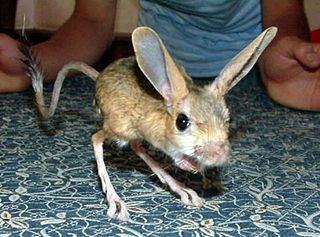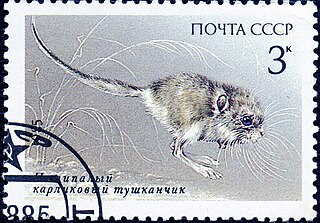
Jerboas form the bulk of the membership of the family Dipodidae. Jerboas are hopping desert rodents found throughout Arabia, Northern Africa and Asia. They tend to live in hot deserts.

The Dipodidae, or dipodids, are a family of rodents found across the Northern Hemisphere, the sole family in the superfamily Dipodoidea. This family includes over 50 species among the 16 genera. They include the jerboas, jumping mice, and birch mice. Different species are found in grassland, deserts, and forests. They are all capable of saltation, a feature that is most highly evolved in the desert-dwelling jerboas.

The four-toed jerboa is a rodent of the family Dipodidae and genus Allactaga that has four digits. It is the sole species in the subgenus Scarturus. Four-toed jerboas are native to Egypt and Libya. They live in coastal salt marshes and dry deserts.
The Balikun jerboa is a species of rodent in the family Dipodidae. It is found in arid areas of northwestern China and Mongolia. It eats green plants, plant roots, seeds, grasshoppers and beetles.

The small five-toed jerboa is a rodent of the family Dipodidae and genus Allactaga, that has five digits. They are hopping rodents of the rocky deserts in Asia. They have been found in Afghanistan, Armenia, Azerbaijan, China, Georgia, Iran, Kazakhstan, Pakistan, Russia, Tajikistan, Turkey, and Turkmenistan. They have long hind feet, short forelimbs, and walk upright. The jerboa body length ranges from 5–15 cm and has a tail ranging from 7–25 cm. They have large ears in comparison to their body size and a large tail. The tail assists and serves as support when the jerboa is standing upright. These hopping rodents can reach a speed up to 48 km/hr. The forelimbs of the jerboa serve as a pair of hands for feeding, grooming, etc. The male jerboa is usually larger in size and weight in comparison to the female jerboa. The pelt of the jerboa is either silky or velvety in texture and light in color, the coloration helps camouflage into surroundings to avoid predators. "Its coloration varies from sandy or buff to dark russet or black with pale under parts and a white strip on the hip”.
The Euphrates jerboa is a rodent of the family Dipodidae and genus Allactaga. They are characteristically known as hopping rodents. They have been found in Afghanistan, Iran, Iraq, Jordan, Kuwait, Saudi Arabia, Syria, and also occurs very marginally in southeastern Turkey. The Euphrates jerboa's natural habitats are semi-deserts, subtropical or tropical dry lowland grassland and hot deserts.

The greater Egyptian jerboa is a species of rodent in the family Dipodidae. It is found in Algeria, Egypt, Libya, Morocco, Saudi Arabia, Tunisia, and is possibly extinct in the Negev Desert of Israel. Its natural habitats are subtropical or tropical dry shrubland, sandy shores, and arable land.
The lesser fat-tailed jerboa is a species of rodent in the family Dipodidae. It is endemic to West, Central, and Eastern Kazakhstan, as well as Northwestern Turkmenistan.
The dwarf fat-tailed jerboa is a species of rodent in the family Dipodidae. It is found in China, Iran, Kazakhstan, Mongolia, and Russia. They mostly reside in desert environments which can explain their size. They go long periods of time without food and water, which means they need a lower metabolic rate, and can be a reason for their size.
The greater fat-tailed jerboa is a species of rodent in the family Dipodidae. It is endemic to Kazakhstan. Its natural habitat is temperate desert.
The thick-tailed pygmy jerboa is a species of rodent in the family Dipodidae. It is found in China, Kazakhstan, and Mongolia. Its natural habitats are temperate grassland and temperate desert. It is threatened by habitat loss. It is listed by the IUCN as being "least concern".
Salpingotus is a genus of rodent in the family Dipodidae. It contains the following species:
Kozlov's pygmy jerboa is a species of rodent in the family Dipodidae. It is found in northwestern China and southern and eastern Mongolia. Its natural habitat is temperate desert.
The Baluchistan pygmy jerboa, or the dwarf three-toed jerboa, is a species of rodent in the family Dipodidae. It is the only species in the genus Salpingotulus. Adults average only 4.4 cm (1.7 in) in head and body length, with the tail averaging 8 cm (3.1 in). Adult females weigh 3.75 g (0.132 oz). It is currently considered to be endemic to Pakistan. In the 1999 Guinness Book of Records, it was listed as tied for the smallest rodent in the world with the African pygmy mouse.
Andrews's three-toed jerboa, or the Mongolian jerboa, is a species of rodent in the family Dipodidae. It is found in China and Mongolia.
Stylodipus is a genus of rodent in the family Dipodidae. It contains the following species:

The thick-tailed three-toed jerboa is a species of rodent in the family Dipodidae. It is found in China, Kazakhstan, Russia, Turkmenistan, Ukraine, and Uzbekistan. Its typical habitat is steppe, desert and mountain grassland where it is often found among saltbush and Artemisia in sandy or clayey soils.

Allactaginae is a subfamily of rodents.

Cardiocraniinae is a subfamily of rodents in the family Dipodidae, named by the Russian zoologist Boris Stepanovich Vinogradov (1891–1958) in 1925. These jumping rodents are small mammals, less than 20 cm long.




